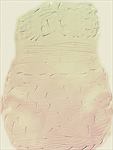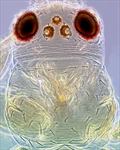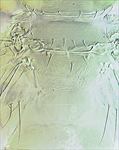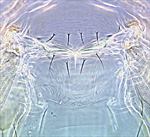
Female

Head & pronotum

Head & pronotum

Antenna

Meso & metanotum

Mesonotum & metanotum

Tergites VI–X

Sternites

Fore wing
Female macropterous; body small and yellow, faint brown markings laterally on tergites, sternites III–VII with dark antecostal ridge; antennal segments I–II pale, III–VII increasingly dark; fore wing pale. Antennae 7-segmented, III & IV each with stout forked sense cone. Head transverse with 3 pairs of ocellar setae, pair III anterolateral to ocellar triangle. Pronotum with no long setae, 5 pairs of posteromarginal setae and 2 pairs of discal setae medially on posterior half. Mesonotum with 4 setae arising in transverse row. Metanotum with median pair of setae not at anterior margin; campaniform sensilla absent. Fore wing first vein with 3 setae on distal half, second vein with 3 or 4 widely spaced setae; posterior cilia wavy. Tergites II–VII with one pair of setae close together medially, lateral thirds of tergites with many rows of closely spaced microtrichia, VIII with long posteromarginal comb, II–VII with comb laterally. Sternites with posteromarginal comb of short microtrichia, VII with median setae arising at margin.
Male similar to female but smaller, without sternal pore plates.
Second instar larva yellow, legs and antennae weakly shaded; antennal segment II without microtrichia but with two large capitate setae at apex; dorsal surface of thorax and abdomen with granular sculpture, spiracles small, major setae short but broadly capitate.
Four species are currently placed in Anascirtothrips, the others being A. discordiae from Taiwan, A. okinawanus from Okinawa, and A. arafura from the northern coast of Australia. Each of these seems to be associated with the leaves of Ficus trees (Mound & Wang, 2000), and they are similar in many structural details to the species of Scirtothrips. However, they have antennae with only seven segments, and the pronotum has at least two discal setae on the posterior half.
Feeding and breeding on young leaves, particularly of Ficus benjiamina [Moraceae], but possibly also on F. microcarpa and some other Ficus species.
Known from India, northern Australia, Israel, and USA (Florida), presumably distributed by the extensive horticultural trade in Ficus plants; this thrips is a potential invader into California.
THRIPIDAE - THRIPINAE
Anascirtothrips arorai Bhatti
Anascirtothrips arorai Bhatti, 1961: 26
Anascirtothrips ficus Bhatti, 1967: 11
Mound LA & Wang CL (2000) The genus Anascirtothrips (Thysanoptera: Thripidae), from leaves of Ficus trees in India, Taiwan and Australia. Chinese Journal of Entomology 20: 327–333.